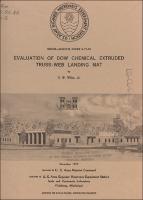Please use this identifier to cite or link to this item:
https://hdl.handle.net/11681/21000Full metadata record
| DC Field | Value | Language |
|---|---|---|
| dc.contributor | United States. Army Materiel Command | - |
| dc.contributor.author | White, D. W. (Dewey W.) | - |
| dc.date.accessioned | 2017-01-17T21:36:20Z | - |
| dc.date.available | 2017-01-17T21:36:20Z | - |
| dc.date.issued | 1972-12 | - |
| dc.identifier.govdoc | Miscellaneous Paper S-72-40 | - |
| dc.identifier.uri | http://hdl.handle.net/11681/21000 | - |
| dc.description | Miscellaneous Paper | - |
| dc.description | Abstract: The inves tigation reported herein was conducted to evaluate 2- by 24-ft truss-web aluminum alloy extrusions without end connectors and truss-web aluminum alloy heavy-duty landing mat designed by Dow Chemical Company, Midland, Mich. The truss-web extrusions were one-piece multi-hollow 6061-T6 aluminum alloy extrusions without end connectors and were 1-1/2 in. thick, 2 ft wide, and 24 ft long. No antiskid material was applied to the extrusions. After the 2- by 24-ft truss-web extrusions were tested under traffic , Dow supplied 2- by 9- ft landing-mat panels, and these were evaluated. The mat is a one-piece multi-hollow extrusion fabricated from 6061-T6 aluminum alloy, 1-1/2 in. thick, 2 ft wide, and 9 ft long, and has antiskid material on the top surface. The investigation of the mat consisted of traffic tests; skid tests; cable roll-over, hook- impact, jet-blast, and temperature-impingement tests; and laboratory tests. The tests were designed to evaluate the service life and performance of the truss-web mat in accordance with the Qualitative Materiel Requirement. Traffic tests were conducted on quantities of the 2- by 24-ft extrusions (internal ribs and side connectors perpendicular to the direction of wheel travel of load cart) without end connectors; 2- by 9-ft truss-web mat placed in the standard placement pattern (side connectors and internal ribs perpendicular to the direction of wheel travel); and 2- by 9-ft mat placed in a longitudinal placement pattern (side connectors and internal ribs parallel to wheel travel). The traffic tests were conducted with the 24-ft-long extrusions and 9-ft-long mats on prepared subgrades using rolling-wheel loads simulating actual aircraft eperations. The truss-web extrusions withstood 1534 coverages (1410 coverages on a subgrade with a 4.0 CBR) and an additional 2466 single-line passes on a 5.0 CBR (total of 4000 passes on one lane of the test section). A total of 2000 coverages (equivalent to 1612 coverages on subgrade with a 4.0 CBR) were applied on the 2- by 9-ft mat in the standard placement pattern before failure occurred. Two hundred coverages (equivalent to 240 coverages on a subgrade with a 4.0 CBR) were applied on the truss-web mat in the longitudinal pattern before the hinging action of the mat allowed the subgrade to flow outward from the center of the test section. This caused a trough to form; thus, the test section was considered failed due to roughness. Laboratory tensile-strength tests conducted on samples taken from the top sheet, ribs, and bottom sheet of truss-web landing mat revealed that the tensile strength of the material was within specified requirements. Further study and testing are recommended in order to develep a waterproof version of truss-web landing mat, which will eliminate the requirement for membrane to be placed beneath the mat to prevent water penetration into the subgrade. This water penetration causes the subgrade strength to deteriorate. Service tests of the truss-web landing mat are recommended to validate the findings of the engineer tests. The standard placement pattern is recommended for use in the service tests. NOTE: This file is large. Allow your browser several minutes to download the file. | - |
| dc.publisher | Soils and Pavements Laboratory (U.S.) | - |
| dc.publisher | Engineer Research and Development Center (U.S.) | - |
| dc.relation | http://acwc.sdp.sirsi.net/client/en_US/search/asset/1047846 | - |
| dc.relation.ispartofseries | Miscellaneous Paper (U.S. Army Engineer Waterways Experiment Station) ; S-72-40 | - |
| dc.rights | Approved for public release; distribution is unlimited. | - |
| dc.source | This Digital Resource was created from scans of the Print Resource | - |
| dc.subject | Aluminum landing mats | - |
| dc.subject | Dow Chemical Company | - |
| dc.subject | Dow landing mats | - |
| dc.subject | Laboratory tests | - |
| dc.subject | Landing mats | - |
| dc.subject | Traffic tests | - |
| dc.subject | Trafficability | - |
| dc.title | Evaluation of Dow Chemical extruded truss-web landing mat | - |
| dc.type | Report | en_US |
| Appears in Collections: | Miscellaneous Paper | |
Files in This Item:
| File | Description | Size | Format | |
|---|---|---|---|---|
| MP-S-72-40.pdf | 30.47 MB | Adobe PDF |  View/Open |